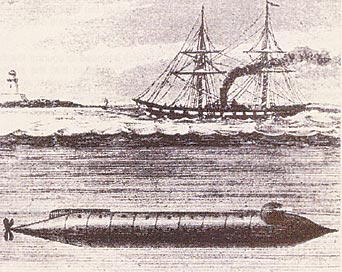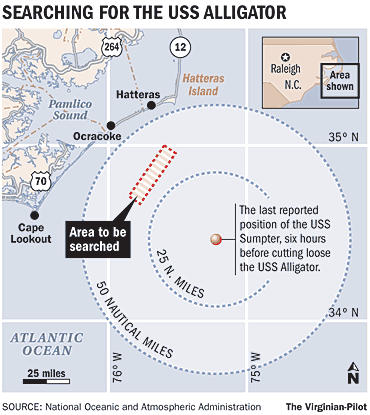U.S. Navy’s Civil War vessel, the "Alligator", believed to be older than the Confederacy’s "Hunley"
_________________________________________________________________
Chicago Tribune
By Michael Kilian
Auguste 21, 2004

A woodcut shows the Navy’s first submarine, the Alligator.
The sub was set adrift in 1863 and never found.
WASHINGTON — Undersea explorers will plunge into the waters off Cape Hatteras and into the depths of long-forgotten history Sunday in hopes of finding the 141-year-old wreckage of the U.S. Navy’s first submarine.
Named the Alligator because of its green color and the leglike oars that initially propelled it, the vessel was launched in 1862. It failed in its assigned missions against Confederate targets in Virginia’s Hampton Roads area and sank off North Carolina’s Outer Banks while under tow in a fierce storm in 1863.
Discovery of the Alligator would undercut the claim of various Confederate historical groups that the Confederate navy’s H.L. Hunley was the first working submarine. Built in 1863 in Mobile, Ala., the 25-foot Hunley sank the Union warship USS Housatonic the following year.
The Hunley wreckage was discovered off Charleston harbor in 1995 and was raised in 2000.
The expedition to discover the Alligator, a joint enterprise of the National Oceanic and Atmospheric Administration and the Navy’s Office of Naval Research, will spend 10 days working a shallow underwater area east of Ocracoke Island, where unidentified sunken objects have recently been discovered.
If this effort fails to find the vessel, future searches ultimately could take the team to deep water on the brink of the Atlantic Shelf.
QUEST THROUGH HISTORY
For decades, historians had identified the USS Holland, an 1897 precursor to the submarines used in World War I, as the Navy’s first submarine. But in recent years, Civil War historians have come across evidence of the existence of the Alligator, prompting the Navy to become extremely interested in locating the 47-foot vessel.
“I had never heard of the Alligator,” said Rear Adm. Jay Cohen, chief of naval research. “I had never read about or seen a reference to it — nothing.”
It was only last year that exploration project manager Catherine Marzin found letters and scale drawings of the sub in an obscure archive in France.
The Alligator was designed by French inventor Brutus de Villeroi, whose papers were in the French archive. It was originally developed for the Union Navy as a counter to the first Confederate ironclad, the CSS Virginia, also called the Merrimack. In the end, it was the Monitor that thwarted the Virginia.
The Alligator was nevertheless launched May 1, 1862, at Philadelphia, where its strange appearance so frightened residents that the vessel was initially confiscated by the Philadelphia police.
Taking possession of it, the Union Navy sent the craft down to the lower Chesapeake Bay area, where it was ordered to destroy a key Confederate bridge over the Appomattox River and remove debris from the James River that was blocking the water route to Richmond.
But the rivers proved too shallow for the Alligator to maneuver, and the submarine had to be withdrawn to the Washington Navy Yard.
President Abraham Lincoln himself took part in the subsequent sea trial observations.
Far ahead of its time, the Alligator was equipped with an air-purification system and a water-tight air lock for divers. The submarine carried a crew of 17 to 22, depending on its mission.
FATEFUL STORM SEALED SUB’S FATE
The Alligator was assigned to take part in Union Navy operations against the port of Charleston.
But taken under tow by the Union warship USS Sumpter in April 1863, it met its doom when the Sumpter encountered a ferocious storm off Hatteras.
The sub was a drag on the other vessel and threatened to sink them both.
“There were two towlines, and one broke,” said Marzin. “The Sumpter had no choice but to cut the other line and set the submarine adrift.”
No crew members were aboard the sub at the time.NOAA and Navy experts have been using computer technology and weather models to try to determine the position of the vessels when the Alligator was cut loose, and to figure out how far it might have traveled before sinking. The expedition team is using a research vessel along with side-seeing sonar and magnetometers.
“No decision has been made about recovering the Alligator,” said Marzin, noting that Titanic discoverer Robert Ballard and other undersea archaeologists have strong feelings against disturbing underwater wrecks.
For the Navy, simply locating the submarine may be enough.
“If we can find the Alligator, we can find anything,” said Cohen.
News article. Another one.
The saga of the submarine.
Alligator Project.
To follow the search for the Allligator, go to http://sanctuaries.noaa.gov/alligator/hunt2004/
For historic information on the Alligator, go to http://sanctuaries.noaa.gov/alligator

____
www.schnorkel.blogspot.com
Chicago Tribune
By Michael Kilian
Auguste 21, 2004

A woodcut shows the Navy’s first submarine, the Alligator.
The sub was set adrift in 1863 and never found.
WASHINGTON — Undersea explorers will plunge into the waters off Cape Hatteras and into the depths of long-forgotten history Sunday in hopes of finding the 141-year-old wreckage of the U.S. Navy’s first submarine.
Named the Alligator because of its green color and the leglike oars that initially propelled it, the vessel was launched in 1862. It failed in its assigned missions against Confederate targets in Virginia’s Hampton Roads area and sank off North Carolina’s Outer Banks while under tow in a fierce storm in 1863.
Discovery of the Alligator would undercut the claim of various Confederate historical groups that the Confederate navy’s H.L. Hunley was the first working submarine. Built in 1863 in Mobile, Ala., the 25-foot Hunley sank the Union warship USS Housatonic the following year.
The Hunley wreckage was discovered off Charleston harbor in 1995 and was raised in 2000.
The expedition to discover the Alligator, a joint enterprise of the National Oceanic and Atmospheric Administration and the Navy’s Office of Naval Research, will spend 10 days working a shallow underwater area east of Ocracoke Island, where unidentified sunken objects have recently been discovered.
If this effort fails to find the vessel, future searches ultimately could take the team to deep water on the brink of the Atlantic Shelf.
QUEST THROUGH HISTORY
For decades, historians had identified the USS Holland, an 1897 precursor to the submarines used in World War I, as the Navy’s first submarine. But in recent years, Civil War historians have come across evidence of the existence of the Alligator, prompting the Navy to become extremely interested in locating the 47-foot vessel.
“I had never heard of the Alligator,” said Rear Adm. Jay Cohen, chief of naval research. “I had never read about or seen a reference to it — nothing.”
It was only last year that exploration project manager Catherine Marzin found letters and scale drawings of the sub in an obscure archive in France.
The Alligator was designed by French inventor Brutus de Villeroi, whose papers were in the French archive. It was originally developed for the Union Navy as a counter to the first Confederate ironclad, the CSS Virginia, also called the Merrimack. In the end, it was the Monitor that thwarted the Virginia.
The Alligator was nevertheless launched May 1, 1862, at Philadelphia, where its strange appearance so frightened residents that the vessel was initially confiscated by the Philadelphia police.
Taking possession of it, the Union Navy sent the craft down to the lower Chesapeake Bay area, where it was ordered to destroy a key Confederate bridge over the Appomattox River and remove debris from the James River that was blocking the water route to Richmond.
But the rivers proved too shallow for the Alligator to maneuver, and the submarine had to be withdrawn to the Washington Navy Yard.
President Abraham Lincoln himself took part in the subsequent sea trial observations.
Far ahead of its time, the Alligator was equipped with an air-purification system and a water-tight air lock for divers. The submarine carried a crew of 17 to 22, depending on its mission.
FATEFUL STORM SEALED SUB’S FATE
The Alligator was assigned to take part in Union Navy operations against the port of Charleston.
But taken under tow by the Union warship USS Sumpter in April 1863, it met its doom when the Sumpter encountered a ferocious storm off Hatteras.
The sub was a drag on the other vessel and threatened to sink them both.
“There were two towlines, and one broke,” said Marzin. “The Sumpter had no choice but to cut the other line and set the submarine adrift.”
No crew members were aboard the sub at the time.NOAA and Navy experts have been using computer technology and weather models to try to determine the position of the vessels when the Alligator was cut loose, and to figure out how far it might have traveled before sinking. The expedition team is using a research vessel along with side-seeing sonar and magnetometers.
“No decision has been made about recovering the Alligator,” said Marzin, noting that Titanic discoverer Robert Ballard and other undersea archaeologists have strong feelings against disturbing underwater wrecks.
For the Navy, simply locating the submarine may be enough.
“If we can find the Alligator, we can find anything,” said Cohen.
News article. Another one.
The saga of the submarine.
Alligator Project.
To follow the search for the Allligator, go to http://sanctuaries.noaa.gov/alligator/hunt2004/
For historic information on the Alligator, go to http://sanctuaries.noaa.gov/alligator

____
www.schnorkel.blogspot.com

0 Comments:
Post a Comment
<< Home